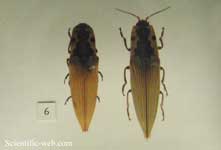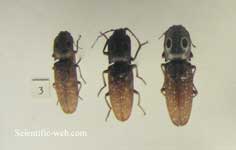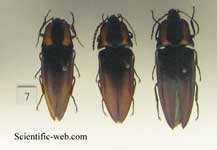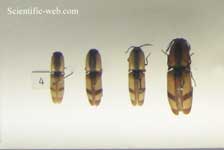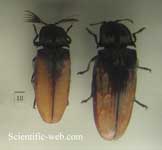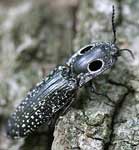|
The family Elateridae is commony called click beetles (or "typical click beetles" to distinguish them form the related Cerophytidae and Eucnemidae), elaters, snapping beetles, spring beetles or "skipjacks". They are a cosmopolitan beetle family characterized by the unusual click mechanism they possess. There are a few closely-related families in which a few members have the same mechanism, but all elaterids can click. A spine on the prosternum can be snapped into a corresponding notch on the mesosternum, producing a violent "click" which can bounce the beetle into the air. Clicking is mainly used to avoid predation, although it is also useful when the beetle is on its back and needs to right itself. There are about 7000 known species. Description and ecology Larvae are slender, elongate, cylindrical or somewhat flattened, and relatively hard-shelled for larvae. The three pairs of legs on the thoracic segments are short and the last abdominal segment is, as is frequently the case in beetle grubs, directed downwards to serve as a terminal proleg. The posterior end of the body is acutely pointed in the larvae of the species of Agriotes that are the best known of the wireworms, but in another common form (the grub of Athous haemorrhoidalis) the tail is bifid and beset with sharp processes. They may pass two or three years in the soil, feeding on the roots of plants, and they often cause much damage to farm crops of all kinds, especially cereals. The subterranean habits of wireworms make it hard to exterminate them when they have once begun to attack a crop, and the most hopeful practice is, by rotation and by proper treatment of the land, to clear it of the insects before sowing. Passing easily through the soil on account of their shape, wireworms travel from plant to plant, and thus injure the roots of a large number in a short time. Other subterranean creatures such as the leather-jacket grub of crane flies which have no legs, and geophilid centipedes, which may have over two hundred, are often confounded with the six-legged wireworms. Larvae of some Brazilian savanna species of click beetles live in burrows scattered over the surfaces of termite mounds using their bioluminescence to attract flying prey.[1] Selected genera * Actenicerus References This article incorporates text from the Encyclopædia Britannica Eleventh Edition, a publication now in the public domain. 1. ^ Digital Photobiology Compendium External links Retrieved from "http://en.wikipedia.org/" |
|
